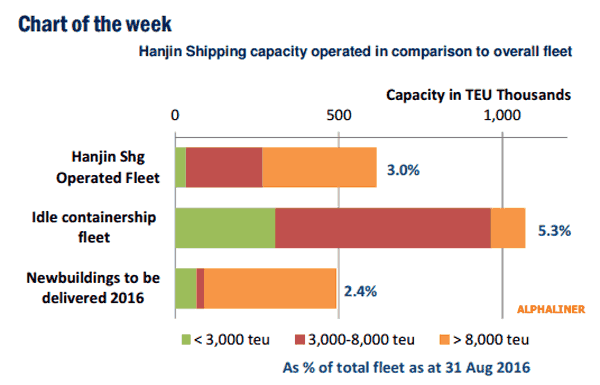The bankruptcy of South Korea's Hanjin Shipping Co. has certainly created temporary chaos in the global ocean container shipping sector, with dozens of Hanjin ships and many billion dollars' worth of cargo basically held up across the world over concerns about who will pay the bills to unload the containers.
That chaos has led to a short term bump in rates for many carriers. Spot rates on the Transpacific and Asia-Europe routes jumped by 25%-50% in the immediate aftermaths of the announcement of Hanjin's bankruptcy filing - though it should be noted that bump came off near record low levels.
Supply Chain Digest Says... |
 |
| The container shipping industry as a whole could lose as much as $10 billion this year on revenues of $170 billion, according to the analysts at Drewry Shipping. |
 |
What do you say? |
| Click here to send us your comments |
 |
| Click here to see reader feedback |
|
|
According to the analysts at Alphaliner, the fears of capacity shortages have faded, as some nine container ships are already In route to or planned for the Asia-US West Coast tours in September, with a further six sailings currently scheduled in October.
On the Asia-Europe trade, only one extra sailing was mounted, while initial plans by Hyundai Merchant Marine to add one full Asia-Europe route have already been scaled down due to weak demand.
Spare capacity has allowed Hanjin's partner carriers in the former CKYHE alliance to shift volumes on other existing Asia-Europe loops, including an new Q3 service. Alphaliner also says "Hanjin's erstwhile partners on the other affected sectors have also moved to replace Hanjin's tonnage with their own ships on their jointly operated services and arranged alternative solutions in order to minimize the impact of the service disruptions brought about by Hanjin's sudden withdrawal."
It looks like rates have a already stabilized and are likely to slip back in the next few weeks before weakening further in October, with China's National Day "Golden Week" holidays beginning in early October marking the start of what has historically been a period of weak demand and falling rates.
The bottom line, Alphaliner says, is that Hanjin represents capacity only in the low single digits in terms of the global fleet, as shown in the chart below.

As can be seen, Hanjin had just 3% of the current operating fleet capacity, and only 2.4% of total container ships on order.
The reality for carriers – and good news for shippers - is that this lost capacity that can easily be replaced by the large amount of capacity slack that has existed in the market for several years now, driven by slowing trade and container volumes coming even as carriers kept adding capacity in the form of ever larger ships. SCDigest notes, however, that just recently carriers have started to make moves (cancelling new ship orders, idling capacity) to turn the supply-demand balance around a bit.
(See More Below)
|
CATEGORY SPONSOR: SOFTEON |
|
|
| |
|
|
The market may take care of some of this imbalance at long last. Some suggest the Hanjin failure may be the first domino to fall in a string of other failures or additional mergers, after it appeared the container carriers for years could somehow defy gravity and continue to operate even as losses mounted. (See Hanjin Bankruptcy Causes Global Logistics Turmoil, and Ends Mirage that Struggling Container Line Won't Go Under.)
Of the biggest 12 shipping companies that have published results for Q2, 11 have announced huge losses. Several weaker carriers are said to be teetering on the edge of bankruptcy. Japan's Mitsui OSK Lines, NYK Line and Kawasaki Kisen Kaisha "look vulnerable," according to The Economist magazine. Though fierce rivals, the three Japanese firms could merge.
Even the carriers financially the strongest are suffering. France's CMA CGM, the world's third-largest carrier, announced a big first-half loss in early September. Meanwhile, Maersk Line, the industry's largest carrier, has said it will be in the red this year, having lost $107 million through June.
The container shipping industry as a whole could lose as much as $10 billion this year on revenues of $170 billion, according to the analysts at Drewry Shipping.
As another data point, German banks and investment funds, which surprisingly own something like 29% of total ocean container ship capacity after a large swell of investments in recent years, are seeing those investments tank.
Almost one-fifth of the 2,200 ships owned by one large funds group are insolvent, analyst firm Deutsche Fondsresearch estimates "The number of emergency sales and/or insolvencies will rise," the firm predicted. "Fresh money from banks or investors is not in sight."
So at long last the free market may take care of excess capacity and rock bottom rates, as it always does - eventually.
Do you believe more container carriers will fail? Will the market finally get back in balance? Let us know your thoughts at the Feedback section below.
Your Comments/Feedback
|